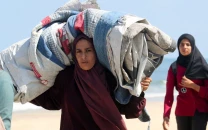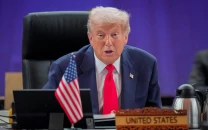Indian govt website declares Muslim-majority IIOJK 'predominantly Hindu'
Demographic description on website 'not innocent' but shows RSS mentality that desires erasure of Muslims, says expert

At a time when fears of a demographic invasion are running rife in Indian Illegally Occupied Jammu and Kashmir (IIOJK), a government website has declared the conflict-ridden Muslim-majority region a Hindu majority.
The InvestJK website, run by the Indian Industries and Commerce Department, describes under its heading on Temples that, "be it Kashmir or Jammu, the population is predominantly Hindu."
"This explains the presence of a number of temples in the state, surrounded by lakes, rivers, snow and alpines," the website reads.
According to government census data, however, only four of IIOJK 20 districts are Hindu majority, with the rest Muslim majority.
While the Kashmir Valley is nearly entirely Muslim, six of the ten districts of Jammu have Muslim-majority populations, although Hindus are the majority in the province when considered as a whole.
The once-in-a-decade census of the erstwhile state of IIOJK last held in 2011 says Muslims represent 68.31% of the population and Hindus 28.44%, the rest being other minorities like Buddhists, Sikhs, Christians and Jains.
Besides contradicting with the government's own population data, the website describes the two regions in terms critics say reek of religious bias rather than an invitation to prospective investors.
The Muslim-majority region is described as a "fertile valley with a mild climate and well known for its handicrafts, in particular its shawls and carpets."
Jammu province is not described in its entirety -- it has a diverse geography and its largest area is inhabited by Muslims. Instead, the website focuses on the province's capital, Jammu. The city is described as being adorned by its founding Dogra rulers "with numerous temples and shrines, [and is] now known as the city of Temples."
"It is dotted with some historical temples like Raghunath Temple, Ranbireshwar Temple, Peer Kho Temple, [and] Panjbakhtar Temple, which are over a hundred years old," it adds.
The region is showcased to investors under three headings: Places to Visit, Temples, and Hill Station. Under Places to Visit are the three famous lakes of the Kashmir Valley and two in Jammu.
"From Amarnath and Raghunath to Vaishnodevi [all Hindu shrines], the state attracts pilgrims in hordes throughout the year, as great religious importance is attached to these places. Most of these are known for their unique architecture, solitude and peaceful environment."
The Temples section describes in detail four Hindu shrines, two each in Occupied Kashmir and Jammu, while the Hill Station section has two famous hill tourist resorts from Kashmir and one from Jammu.
Incorrect population figures and failure to name any of the hundreds of religious places in the Kashmir Valley have evoked sharp criticism.
'Religiously motivated'
"How does describing the population of a region in religious terms matter to a prospective investor unless some ulterior motive is behind doing so? And how can you mislead an investor with completely false facts? Would he not find out which group is in the majority once he invests here if at all he decides to invest in the first place?" Sheikh Ashiq, president of the Kashmir Chamber of Commerce and Industry, told Anadolu Agency.
Ashiq said the "same mentality appears to be at work here as the one that tried to paint Muslims as spreaders of Covid-19." He said his organisation would flag the issue with the relevant authorities.
Hassnain Masoodi, a member of the Indian parliament from IIOJK and former chief justice of the IIOJK High Court, told Anadolu Agency that the Muslim-majority character of the region was celebrated by Indian leaders.
"One cannot rule out a hidden agenda behind this falsification of the facts," he said.
According to Sheikh Showkat Hussain, a former professor of law, author and columnist, this demographic description on a government website was "not innocent."
"This shows the RSS [Rashtriya Swayamsevak Sangh] mindset that desires the erasure of Muslims has percolated to government institutions," he told Anadolu Agency.
The RSS is a Hindu supremacist organisation. The Narendra Modi-led Bharatiya Janata Party (BJP) ruling India at present is one of several organisations affiliated with it.
Anadolu Agency's repeated calls to the officials concerned have gone unanswered.
Demographic invasion
Fears of Hindus overwhelming the Muslim majority of the region — which has a population of 12.5 million — have been widely expressed by both pro-freedom and pro-India Muslim leaders after Aug 5, 2019, when India scrapped a law that barred outsiders from purchasing property or applying for government jobs in the region.
Since then, the Indian government has introduced laws making it easier for outsiders to apply for residency, as well as purchasing a property.





1701351241-1/Afghan-refugees-(3)1701351241-1-208x130.webp)













COMMENTS
Comments are moderated and generally will be posted if they are on-topic and not abusive.
For more information, please see our Comments FAQ